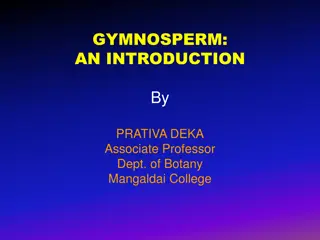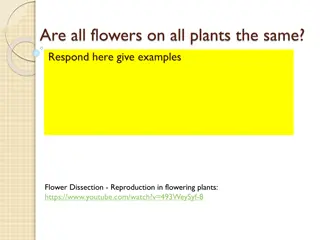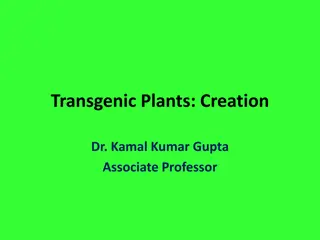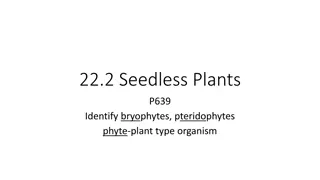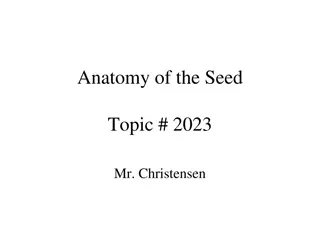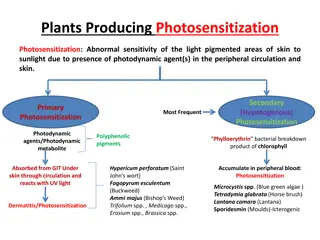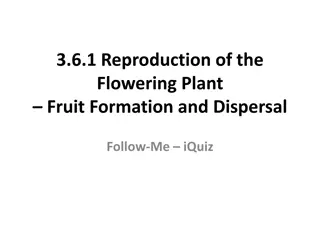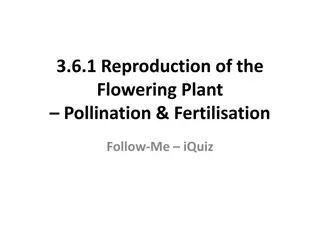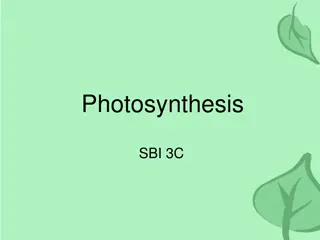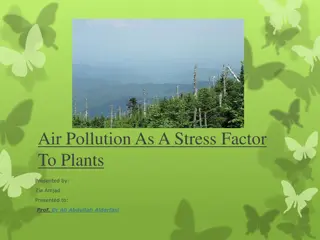Understanding Endosperm Development in Plants
Endosperms are crucial for embryo development, providing nutrients and starch. There are two main types of seeds based on endosperm utilization: albuminous and exalbuminous. Endosperm development involves three types: nuclear, cellular, and helobial. Nuclear endosperms feature free-nuclear divisions, cellular endosperms form segments with cell wall formation, and helobial endosperms exhibit an intermediate structure. The seed coat, derived from integuments of the ovule, plays a vital role in seed protection and dispersal in plants.
Download Presentation

Please find below an Image/Link to download the presentation.
The content on the website is provided AS IS for your information and personal use only. It may not be sold, licensed, or shared on other websites without obtaining consent from the author. Download presentation by click this link. If you encounter any issues during the download, it is possible that the publisher has removed the file from their server.
E N D
Presentation Transcript
Endosperm Development The endosperms are very vital parts of the fertilized embryo. An endosperm forms the surrounding tissue of the growing embryo. They are the primary storage tissue and their main function is to provide starch and other nutrients to the growing embryo. Types of Seed Depending on the utilization of the endosperm, there are two types of seeds: Albuminous seed: The endosperms provide nutrition to the developing embryo but remain even during the germination of the seed in this type. Exalbuminous seed: This endosperms completely. Thus, endospermic in nature. type of seed seeds utilizes are the these non-
Development of Endosperm There are three types of Endosperms: a) Nuclear b)Cellular c)Helobial Let us understand a phenomenon called as double fertilization . Each pollen grain consists of two male gametes. Once they reach the ovary, one of the male gametes fuses with the female gamete and forms the zygote. The other male gamete fuses with the central cell which is diploid resulting in the formation of a triploid endosperm. But, in gymnosperms, the endosperm is haploid. Nuclear Endosperms: In this type, the cell divisions are free-nuclear divisions where each cell division is not followed by formation of a cell wall. They may or may not form a cell wall towards later stages. With the cell divisions, the nuclei are pushed towards the periphery of the sac giving rise to a large vacuole in the centre. This type of endosperm is the most common type and is found in maize, wheat, areca nut and coconut. The endosperm of the coconut gives rise to a large central vacuole that gets eventually filled up with the nutritious coconut water.
Cellular Endosperms: This type is the opposite of the nuclear endosperm. In this type, Cell wall formation follows each cell division. Thus, the endosperm divides into many segments. There might not be coherency in the divisions and they can happen along different planes. Cellular divisions of the endosperm consequently lead to the formation of the coconut meat. Plants like petunia and Dhatura have this kind of endosperm. Helobial Endosperms: This is an intermediate form between the other two types. In this type, Cell wall formation follows the first cell division. But the subsequent divisions do not lead to cell wall formation. The first cell division occurs along the transverse plane giving rise to clear micropylar and chalazal ends. The subsequent division after the first often occurs in the micropylar end. Once the number of division in the micropylar end begin to increase, the chalazal end starts to degenerate or disintegrate
Seed Coat Structure Seed coat: The maturing ovule undergoes marked changes in the integuments, generally a reduction and disorganization but occasionally a thickening. The seed coat forms from the two integuments or outer layers of cells of the ovule, which derive from tissue from the mother plant, the inner integument forms the tegmen and the outer forms the testa. (The seed coats of some monocotyledon plants, such as the grasses, are not distinct structures, but are fused with the fruit wall to form a pericarp.) The testae of both monocots and dicots are often marked with patterns and textured markings, or have wings or tufts of hair. When the seed coat forms from only one layer, it is also called the testa. The funiculus abscisses (detaches at fixed point abscission zone), the scar forming an oval depression, the hilum. Anatropous ovules have a portion of the funiculus that is adnate (fused to the seed coat), and which forms a longitudinal ridge, or raphe, just above the hilum. In bitegmic ovules (e.g. Gossypium described here) both inner and outer integuments contribute to the seed coat formation. With continuing maturation the cells enlarge in the outer integument. While the inner epidermis may remain a single layer, it may also divide to produce two to three layers and accumulates starch, and is referred to as the colourless layer.
Gymnosperms: In gymnosperms, which do not form ovaries, the ovules and hence the seeds are exposed. This is the basis for their nomenclature naked seeded plants. Two sperm cells transferred from the pollen do not develop the seed by double fertilization, but one sperm nucleus unites with the egg nucleus and the other sperm is not used. Sometimes each sperm fertilizes an egg cell and one zygote is then aborted or absorbed during early development. The seed is composed of the embryo (the result of fertilization) and tissue from the mother plant, which also form a cone around the seed in coniferous plants such as pine and spruce.


